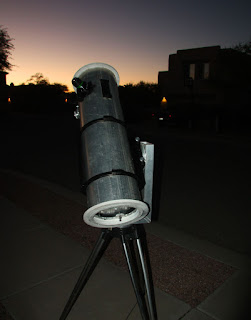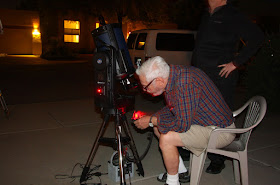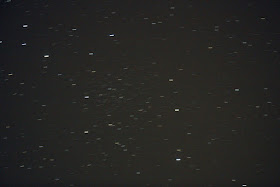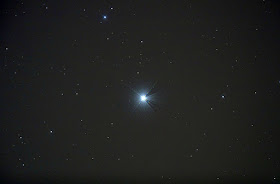 Our friend Dick had put out a call about midweek last week pointing out that good weather was forecast and he had a number of newly acquired scopes to try out. Dick is an optical designer by trade as well as a bit of a connoisseur , purchasing (normally) used equipment, trying them for days or weeks, then selling them back on the market for the same or bargain prices. His specialty is refractive optics - those that use lenses to focus the light for the eyepiece to magnify before going into the eye. Since there isn't really any such thing as a perfect refractive optic (they all have at least miniscule flaws), he ferrets out the details of why a particular design can work well, or more typically, is mediocre or of poor quality.
Our friend Dick had put out a call about midweek last week pointing out that good weather was forecast and he had a number of newly acquired scopes to try out. Dick is an optical designer by trade as well as a bit of a connoisseur , purchasing (normally) used equipment, trying them for days or weeks, then selling them back on the market for the same or bargain prices. His specialty is refractive optics - those that use lenses to focus the light for the eyepiece to magnify before going into the eye. Since there isn't really any such thing as a perfect refractive optic (they all have at least miniscule flaws), he ferrets out the details of why a particular design can work well, or more typically, is mediocre or of poor quality.I've been working on refurbishing a telescope (more on that in a subsequent post), and was about to the point where I wanted to take it to a dark site, but Melinda was up for some social activity, so we attended. My 11.25" Newtonian scope uses a concave mirror to focus light off a smaller secondary mirror to the eyepiece. On this night, it was handy to use the alt-az mount I made for my TEC 140, so pointing was done by shoving it away or towards you, and up or down to find various objects. A couple views of the scope on the mount are shown here.

 I had some work to do on it - a final
I had some work to do on it - a final collimation (alignment) of the optics on a star, after doing a preliminary version with a laser beforehand. With the 17mm eyepiece I used, we got nearly 60X, which was just about perfect for manually moving around the sky with such a largish instrument. Thinking ahead to a blog post, I thought I'd try a selfie with a big, bright object like the Pleiades that was low in the east. Setting up the tripod and camera, I used a delay, ratcheted down flash, and a long exposure (30 seconds) to catch the scene with myself and star cluster. It only took 3 attempts to get the "perfect" image shown at left.
Dick held little interest in reflective optics - not sure he even looked thru my scope, but he had just gotten one of his "babies" back from factory repair. His Meade LS8 is advertised as the perfect scope for newbies as it uses GPS technology and a built-in camera to find its way around the sky and give the user a sky show with no knowledge of where anything is located. After obtaining it used, it never worked satisfactorily, and it spent 4 months getting "fixed". At right, Dick looks at an object that it found. The happy ending is that after failing to find its way around the sky initially, after turning it off and back on, it worked!
The star party was rather under-attended, but the 4 astro-nerds had fun, and we took occasional breaks to go into the house and mingle with the Significant Others. We all got a good look at a couple of 4" diameter F/8 refractors of high quality, and with Dick's tutelage, looked for the indicators that pointed out the flaws in one of them. Thanks to Dick and the other attendees to make it a memorable evening - always fun to be under a clear sky with friends, even with some light pollution!

 We didn't stay late - Melinda tires easily and I was anxious to put my camera in place of the eyepiece to take a couple images. But I'd forgotten a key camera adaptor piece, so had to wait till we got home. Set up in the front yard, with the non-tracking mount, the only object I could shoot with more than a few seconds of exposure was the North Star - Polaris, shown here at left in a 30 second exposure. There is a weird artifact in the diffraction pattern on the bright star - I suspect that it is because it is in a tube that is a little small (12" diameter) for the size mirror (11.25"). In addition, I think the coma corrector, which fixes the aberration in fast reflectors, sticks into the beam slightly, so that is the likely cause. But for 30 seconds, in town, most stars are pretty tiny, so I'm pleased. If you click the image for the full-size view, you will see there is even a little trailing in 30 seconds so close to the pole star. Just for fun, I decided to move the scope about 5 degrees south to NGC 188, a star cluster very close to Polaris. Shown at left, note that the same 30 second exposure shows a huge amount of trailing!
We didn't stay late - Melinda tires easily and I was anxious to put my camera in place of the eyepiece to take a couple images. But I'd forgotten a key camera adaptor piece, so had to wait till we got home. Set up in the front yard, with the non-tracking mount, the only object I could shoot with more than a few seconds of exposure was the North Star - Polaris, shown here at left in a 30 second exposure. There is a weird artifact in the diffraction pattern on the bright star - I suspect that it is because it is in a tube that is a little small (12" diameter) for the size mirror (11.25"). In addition, I think the coma corrector, which fixes the aberration in fast reflectors, sticks into the beam slightly, so that is the likely cause. But for 30 seconds, in town, most stars are pretty tiny, so I'm pleased. If you click the image for the full-size view, you will see there is even a little trailing in 30 seconds so close to the pole star. Just for fun, I decided to move the scope about 5 degrees south to NGC 188, a star cluster very close to Polaris. Shown at left, note that the same 30 second exposure shows a huge amount of trailing!The key is to use the tracking mount (that takes a lot more to set up) which allows exposures of unlimited length from a dark sky - sometime soon, I hope!

No comments:
Post a Comment
We value your comments, but no spammers, please!